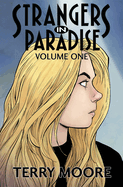
What at first seems a charming slice-of-life tale about two 20-something roommates becomes a daring romp through the politics of sex, love, and mob violence in this edition of Terry Moore's beloved Strangers in Paradise comic book series. The volume, at 480 pages, comprises the first quarter of the complete serial, and includes the same arresting black-and-white panels and zany dialogue long-time fans will remember from their youth. But even those who did not read the series during its original run from 1993 to 2007 will find this repackaged volume accessible, if not downright addicting.
The story largely follows three main characters: the kindhearted but insecure Helen Francine Peters, aka Francine; the emotionally volatile but steadfast Katina Marie Choovanski, aka Katchoo (yes, pronounced like a sneeze); and their patient, artistic pal David Qin. Francine and Katchoo are best friends and roommates. Katchoo is secretly in love with Francine. Both are friends (or maybe more) with David, who's in love with Katchoo. Katchoo considers herself a lesbian... or, anyway, she thinks so. It's all a bit confusing for everyone, a dynamic only further complicated by the crime-thriller components Moore sprinkles in like an unorthodox garnish. All together, however, the ingredients work: the comic-book form is the ideal medium for such experiments, and Moore makes the chemistry a blast.
As Katchoo's history as an underage call girl named Baby June becomes clearer on the page, so, too, does her connection with another tangle in the love web: she was once both agent for and lover of Darcy Parker, part of the Parker Crime Syndicate and also... David's sister. If readers struggle to keep these narrative threads straight, that's intentional. (It's also part of the fun.) Reading Strangers in Paradise is necessarily immersive; the story requires more than a cursory investment in order to reap the full rewards of Moore's panels. There's a reason this volume of Strangers in Paradise is only the latest of several collecting and reissuing the cult classic series. The story, and its graphic novel form, are stuffed with careful details, often requiring multiple read-throughs to recognize. Combined, these components fuse to form characters that--however absurdist--are difficult not to love.
Moore plays with stereotypes and clichés throughout the book, employing them as often as he subverts them. Those readers who find the old-school rhythms of comic-book tropes comforting will discover much to appreciate. Take, for instance, the crime syndicate, which employs a ring of women--known as "Parker Girls"--to interfere with democratic processes and execute figureheads. Is such an invention ridiculous? Absolutely, but no less absurd than the superhero tales that regularly dominate pop culture. That pop lingo, by the way, is similarly wielded by Moore in his characters' dialogue, both as a self-critique and a self-indulgence. In one chapter, Katchoo suffers a near-death experience, and copes with the trauma through practiced nonchalance: "But if I have to keep slogging through day after day of this slam dance called life, at least I have a beautiful partner to do it with. I mean, how many people are lucky enough to have a gorgeous woman who'll stand by them... no matter what. ...well, besides Hugh Grant. Come on, work with me here. This is my story. Sheesh!"
Still, it is Strangers in Paradise's place within the context of graphic-novel history that cements its continued importance, and makes the case for the release of this new volume. The series was one of the first of its genre to feature unabashedly queer characters throughout its run, earning it several GLAAD Awards, as well as an Eisner. And while the feminist notions and body politics with which Katchoo and Francine wrestle might seem tired by today's standards, they were downright forward-thinking at the time of their publication; nor are they now so old-hat as they might seem. Many of Strangers in Paradise storylines--from Francine's conservative religious upbringing to Katchoo's sexual confusion to the toxic sway of crime and capitalism--remain as relevant now as they were in the '90s. Comparing and critiquing these themes in a modern context is part of the pleasure of revisiting this book.
Moore promises plenty to come after Volume 1, with plans to eventually collect the entire Strangers in Paradise run across four books. Other collected versions, including the previously published omnibuses and so-called "pocket books," will not be reprinted, making this new release the best way to read the series in its entirety. Die-hard fans will particularly appreciate the fresh full-color covers Moore is designing for each volume, and just as many will rediscover joy inside those covers as well: Moore's creative use of panel organization and occasional arresting full-page illustrations are just as memorable as they were years ago. In spite of Moore's decades of success, there's never been a better time to meet his Strangers than now. --Lauren Puckett-Pope

